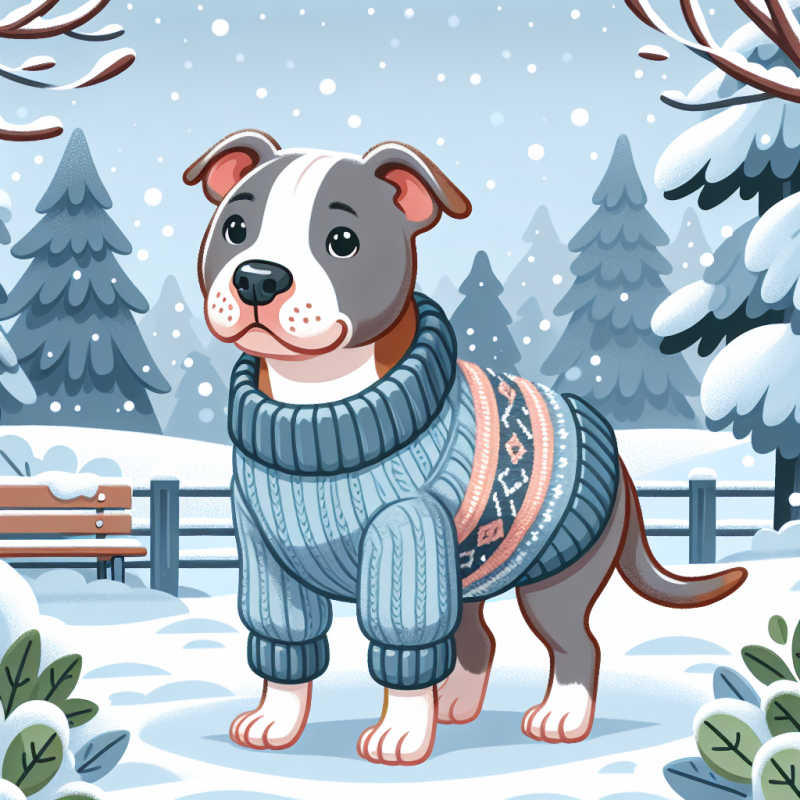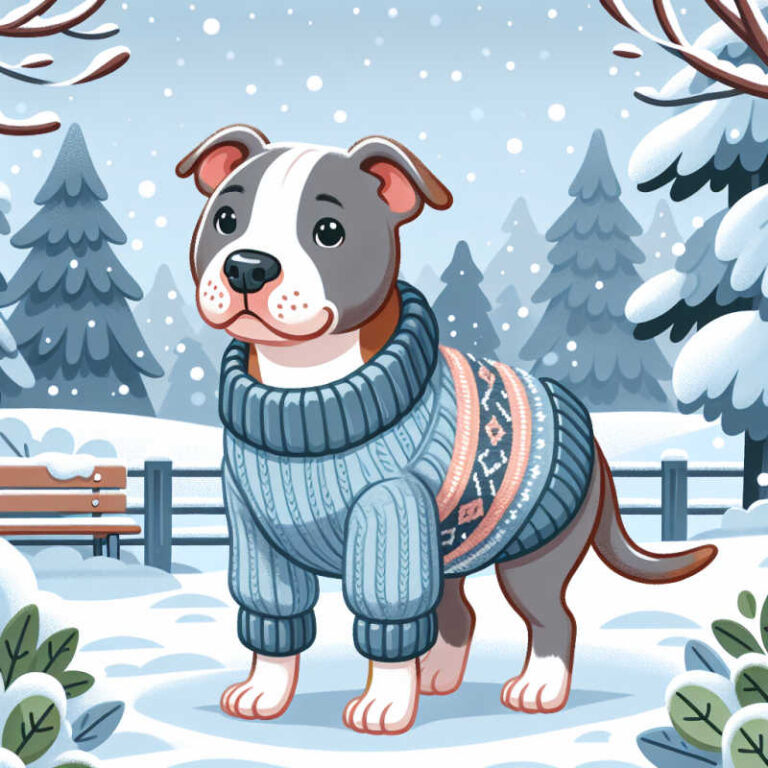Did you know that nearly one in five dog owners notice their pets struggling with colder temperatures? As the chill sets in, pitbulls may exhibit signs of discomfort due to factors like their age, weight, and coat type. Understanding how to recognize when your pitbull is feeling cold, the elements that increase their sensitivity, and effective ways to keep them warm is crucial for their health and happiness. From choosing the right winter apparel to being aware of potential health risks, this guide provides comprehensive strategies to ensure your pitbull remains cozy and safe during the colder months. We encourage you to share your own experiences and tips as we delve into the best practices for caring for your pitbull in winter weather.

- Recognizing Cold Symptoms in Pitbulls
- Key Factors Determining How Cold Affects Your Pitbull
- How to Keep Your Pitbull Warm During Cold Weather
- The Best Clothing and Accessories for Pitbulls in Winter
- Health Risks Associated with Cold Exposure in Pitbulls
- When to Consult a Veterinarian About Cold-Related Issues
Contents
- 1 Recognizing Cold Symptoms in Pitbulls
- 2 Key Factors Determining How Cold Affects Your Pitbull
- 3 How to Keep Your Pitbull Warm During Cold Weather
- 4 The Best Clothing and Dog Accessories for Pitbulls in Winter
- 5 Health Risks Associated with Cold Exposure in Pitbulls
- 6 When to Consult a Veterinarian About Cold-Related Issues
- 7 Frequently Asked Questions
Recognizing Cold Symptoms in Pitbulls
Keeping a close eye on your pitbull’s health is crucial, especially during chilly weather. Unlike some breeds that thrive in colder climates, pitbulls can exhibit specific symptoms indicating they’re feeling the cold. Recognizing these signs early can help you take prompt action to ensure your furry friend stays comfortable and safe.
Common cold symptoms in pitbulls include:
- Shivering or trembling persistently
- Lethargy or decreased energy levels
- Changes in behavior, such as increased irritability or clinginess
- Seeking warm places more frequently
- Visible whitening of paw pads due to cold exposure
To better understand how these symptoms compare to other breeds, refer to the table below:
| Symptom | Pitbulls | Golden Retrievers | Chihuahuas |
|---|---|---|---|
| Shivering | Common in cold weather | Less frequent due to thicker coats | Very common, even in mild temperatures |
| Lethargy | Noticeable decrease in activity | Mild reduction in playfulness | Fast onset with minimal activity |
| Seeking Warmth | Often retreats to warm areas | Uses bedding more frequently | Constantly seeks body heat from owners |
Understanding these differences helps in tailoring care strategies for your pitbull. Providing adequate winter gear, such as dog sweaters or boots, can mitigate these cold symptoms. Additionally, ensuring your pitbull has access to warm, cozy spaces and monitoring their behavior can make a significant difference in their comfort during colder months.
Key Factors Determining How Cold Affects Your Pitbull
Your Pitbull’s ability to handle the cold isn’t one-size-fits-all. Several critical elements play a role in their cold sensitivity, making it essential to understand each one to keep your furry friend comfortable during chilly months.
Here are the main factors that influence how well a Pitbull copes with the cold:
- Age: Younger and older Pitbulls are more vulnerable to temperature extremes. Puppies haven’t fully developed their coat, while senior dogs may have decreased metabolic rates, making it harder for them to stay warm.
- Weight: A Pitbull’s weight directly impacts their insulation. Underweight dogs may struggle to retain heat, whereas those with a healthy weight typically have better natural insulation.
- Coat Type: While Pitbulls generally have short coats, variations in thickness and density can affect their warmth. Dogs with a thicker, denser coat are naturally more resistant to the cold.
- Overall Health: A Pitbull in good health is better equipped to handle colder temperatures. Conditions like hypothyroidism or arthritis can make cold weather more uncomfortable and potentially dangerous for them.
Understanding these factors helps you make informed decisions about providing the necessary winter care for your Pitbull, ensuring they stay healthy and happy even when the mercury drops.
How to Keep Your Pitbull Warm During Cold Weather
When the temperatures drop, ensuring your Pitbull stays warm is crucial for their health and happiness. Cold weather can be brutal, but with the right strategies, your loyal companion can stay comfortable and safe. Here are some effective ways to keep your Pitbull cozy during the chilly months:
- Provide Adequate Shelter: Make sure your Pitbull has access to a warm, dry shelter when outdoors. A well-insulated dog house with raised flooring and windproof walls can make a huge difference.
- Invest in Quality Bedding: Use thick blankets or orthopedic beds to give your Pitbull extra warmth and support. Placing bedding away from drafts helps maintain a consistent temperature.
- Regular Outdoor Walks: While it’s essential to limit time outside during extreme cold, regular walks keep your Pitbull active and generate body heat. Always monitor for signs of discomfort or frostbite.
- Use Protective Clothing: Dog jackets or sweaters can provide an additional layer of warmth, especially for Pitbulls with shorter coats. Choose waterproof and wind-resistant materials for maximum protection.
By implementing these tips, you can ensure your Pitbull remains warm and content, even when the mercury drops. Remember, a happy Pitbull is a healthy Pitbull, so take the necessary steps to safeguard them against the cold.
The Best Clothing and Dog Accessories for Pitbulls in Winter
Let’s be real: winter can be tough on your pitbull. To keep them snug and happy, you need the right clothing and accessories. A durable dog jacket is a must-have—it blocks those harsh winds and retains body heat. Look for jackets made from water-resistant materials with reflective strips to keep your pup safe during those short, chilly days. Don’t forget boots; they protect sensitive paws from ice, salt, and rough sidewalks. Experts recommend boots with non-slip soles and breathable fabrics to ensure your pitbull stays comfortable and mobile.
Think a winter sweater is just for style? Think again. A well-fitted sweater adds an extra layer of insulation, perfect for pitbulls with shorter coats or those who spend a lot of time outdoors. Veterinarians agree that layering clothing helps regulate body temperature, preventing your dog from getting too cold outside and too warm indoors. Choosing the right gear isn’t just about fashion—it’s about enhancing your pitbull’s quality of life during the colder months.
| Accessory | Key Features | Advantages |
|---|---|---|
| Dog Jackets | Water-resistant, reflective strips, adjustable fit | Protects against wind and keeps your dog visible |
| Boots | Non-slip soles, breathable fabrics, secure closure | Prevents paw injuries and provides better traction |
| Winter Sweaters | Soft material, easy to wear, machine washable | Adds an extra layer of warmth and comfort |
Health Risks Associated with Cold Exposure in Pitbulls
Exposing your Pitbull to cold weather can lead to serious health risks that shouldn’t be taken lightly. Unlike some breeds, Pitbulls have a lean physique which makes them more susceptible to the harsh effects of low temperatures. Understanding these dangers is crucial to ensuring your furry friend stays safe and comfortable during chilly months.
- Hypothermia: This occurs when your dog’s body temperature drops below the normal range. Symptoms include shivering, lethargy, and in severe cases, unconsciousness. Immediate veterinary attention is required to prevent long-term damage.
- Frostbite: Cold exposure can cause frostbite, especially on extremities like ears, paws, and tail. Look out for discoloration, swelling, and pain in these areas. Protecting your Pitbull with appropriate clothing can help mitigate this risk.
- Respiratory Issues: Breathing in cold air can exacerbate existing respiratory conditions or lead to new problems such as bronchitis. Monitor your Pitbull for coughing, difficulty breathing, or excessive panting when outside in the cold.
Preventing these health issues involves proactive measures like providing warm shelter, limiting outdoor time during extreme cold, and using protective gear such as dog sweaters or boots. Always be vigilant for the early signs of cold-related illnesses to keep your Pitbull healthy and happy all year round.
When to Consult a Veterinarian About Cold-Related Issues
Even the toughest Pitbulls aren’t immune to the biting chill. If your dog starts showing signs of distress in cold weather, it’s time to take action. Look out for:
- Shivering or trembling – Persistent shaking isn’t just cute; it could mean your pitbull is struggling to stay warm.
- Lethargy and weakness – A sudden drop in energy might indicate hypothermia, where your dog’s body temperature is dangerously low.
- Discolored paws, ears, or tail – This is a red flag for frostbite, which can cause serious tissue damage if not treated immediately.
- Difficulty breathing – Cold-induced respiratory issues are a serious concern and require urgent veterinary attention.
Prolonged exposure to freezing temperatures without proper shelter can escalate these issues quickly. If you notice any of these symptoms, don’t wait—contact your veterinarian right away to ensure your pitbull stays safe and healthy during the cold months.
Frequently Asked Questions
Can Pitbulls Sleep Outside in Cold Weather?
While Pitbulls are resilient dogs, it’s generally not recommended to let them sleep outside in extremely cold weather. Providing a warm, insulated shelter indoors ensures they stay comfortable and reduces the risk of cold-related health issues.
How Can I Tell if My Pitbull is Too Cold?
Signs that your Pitbull may be too cold include excessive shivering, whining, reluctance to move, and seeking warmth by curling up tightly. If you notice these behaviors, it’s important to provide additional warmth immediately.
Are There Specific Indoor Activities to Keep My Pitbull Active During Winter?
Yes, engaging your Pitbull in indoor activities such as puzzle toys, obedience training, and interactive games can help keep them physically and mentally stimulated during the colder months when outdoor exercise may be limited.
Do Pitbulls Need Special Grooming in Cold Weather?
Regular grooming is important year-round, but in cold weather, maintaining a healthy coat helps insulate your Pitbull against the cold. Brushing regularly removes loose fur and prevents matting, which can compromise their ability to stay warm.
What Should I Look for When Choosing Winter Clothing for My Pitbull?
When selecting winter clothing for your Pitbull, look for items that provide adequate insulation, are made from waterproof or water-resistant materials, and fit comfortably without restricting movement. It’s also important to choose fabrics that are safe and non-irritating to your dog’s skin.


